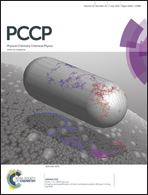Mn-modified Bi2Ti2O7 photocatalysts: bandgap engineered multifunctional photocatalysts for hydrogen generation†
Abstract
In this study, a hydrogen generation photocatalyst based on bismuth titanate (Bi2Ti2O7 – BTO) modified with manganese (Mn) has been developed. Mn of varying weight percent was added to construct a modified BTO catalyst (Mn_BTO), in order to enhance the opto-electronic and photocatalytic hydrogen generation capabilities of the pristine BTO. The structural, morphological, and optical properties of the photocatalysts were evaluated by X-ray diffraction (XRD), scanning electron microscopy (SEM), transmission electron microscopy (TEM), and UV-visible spectrophotometry. The XRD, SEM, and TEM analyses indicate the formation of the pyrochlore BTO phase with particles of dimensions 30 ± 10 nm. The UV-visible study revealed a reduction in the bandgap of Mn_BTO and enhanced absorption in the visible range, compared to the pristine BTO. The catalyst was optimized for maximum hydrogen generation from a water–methanol (sacrificial electron donor) system in a slurry reactor. The photocatalytic hydrogen evolution studies indicate that the Mn_BTO with up to 1 wt% Mn facilitates an optimal 140% increase in the hydrogen yield. The role of formic acid and formaldehyde as additives in photocatalytic hydrogen evolution has also been examined. The effect of Mn content, mechanistic overview, and reusability of the catalyst are discussed.


 Please wait while we load your content...
Please wait while we load your content...